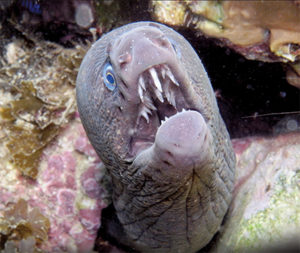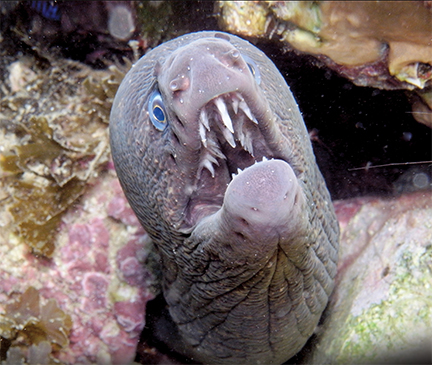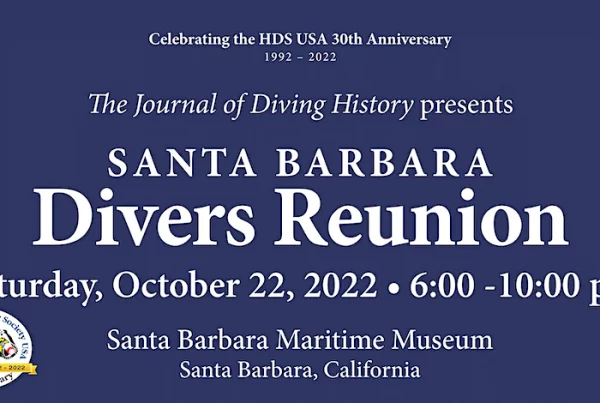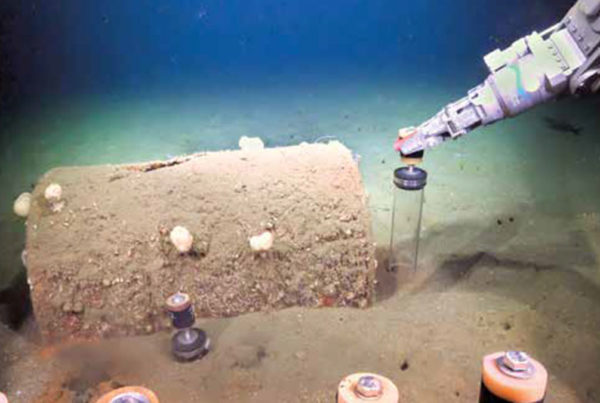 Did you know that the moray eels found in Southern California waters (the California moray, Gymnothorax mordax) are actually semi-tropical visitors? It is thought that our local waters are too cold to serve as eel breeding areas. Instead of being “born” here, larval eels hitchhike here on the currents from warmer waters to the south.
Did you know that the moray eels found in Southern California waters (the California moray, Gymnothorax mordax) are actually semi-tropical visitors? It is thought that our local waters are too cold to serve as eel breeding areas. Instead of being “born” here, larval eels hitchhike here on the currents from warmer waters to the south.
While it is not unusual to find an individual animal here and there, there are spots that are abundant with eels. One such spot is often referred to as Eel Land on the front side of Catalina. Eel Land is situated between two other popular dive sites; Twin Rocks is to the east and Goat Harbor to the west. All three are easy dives and if you anchor at Eel Land, it is possible to swim to the other two, although we suggest you dive each of these three sites separately for maximum enjoyment.
The numbers of eels at Eel Land is not overwhelming, nor are they exceptionally large, but what makes this a special place is the friendliness of the creatures. Most morays cower back into a corner or hole when approached, making photography and observation difficult. Not here. While not aggressive, they have a tendency not to shy away from photographers. Even so, be careful. Moray eels have an excellent sense of smell but their eyesight is poor. Don’t wave your fingers too close to their sharp teeth or you could risk being nipped by accident.
There are some tricks for photographing morays for maximum effect. They have incredible faces that can be photographed in one of two ways. Depending on the angle and lighting, they can look fierce or happy — same critter, just moments apart. For the fierce look, use harsh side lighting either with one strobe or a significant power difference between two strobes. Morays pass water over their gills with big open-mouth gulps. Time your shot when they open their mouth and you’ll get a photo full of sharp teeth. They will also open their mouths big if threatened. You could poke something at them but you do so at your own risk! Some of the morays at this spot will come out at you open-mouthed even without prompting. Do not make contact with them as this will remove their slimy coating and make them vulnerable to disease. To get that happy moray shot, use softer more even light, take a higher angle and wait until the mouth is closed. They have a natural “smile” that can be captured in this way.
The bottom terrain is also ideal for other fun reef critters of all shapes and sizes. Boulders in a variety of sizes have tumbled down from the steep rock faces ashore creating a moderately steep boulder field underwater. Cracks, crevices and holes hold, in addition to the morays, treefish, horn sharks, and lobster. You might even spot an abalone or two. Attached to the rocks is a seasonal thin kelp forest with garibaldi, calico bass, opaleye, small sheephead, and blacksmith. As you explore, keep your eyes peeled for giant black sea bass that are known to often cruise these waters spring through summer. They like to hang out at the level of the thermocline, usually between 30 and 50 feet winding their way through the thin kelp strands.
The best area, both for morays and other marine life is in the 35-to 55-foot range. The rocks give way to a gently sloping sand bottom at about 60 feet. Don’t ignore the sand as you may spot a bat ray or small halibut. While there is plenty to see in the area you could make a loop dive by either heading to Twin Rocks or Goat Harbor. Or if you dive either of these sites, you could make Eel Land as the apex of your loop. There are a lot of possibilities here.
At-A-Glance
Skill Level: All
Location: Between Twin Rocks and Goat Harbor on the front side of Catalina. GPS N33°25’3.56”, W118°23’31.98”. Both Twin Rocks and Goat Harbor are usually marked on charts but not Eel Land.
Access: Boat only. Professional charter boat recommended. There are several out of Long Beach and San Pedro. Private boat launch ramps are available at these same harbors as well.
Entry and Exit: Usually easy as seas are generally calm here and currents light.
Depth Range: 20 to 65 feet
Visibility: Very good, averages 40 feet
Photography: Best for macro and standard of eels and other small to medium critters. Wide-angle is okay except for the huge black sea bass, for which wide-angle is a must.
Hunting: None. State Marine Preserve.
Cautions: Boat traffic.










